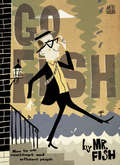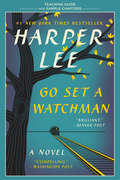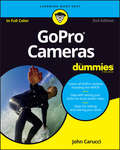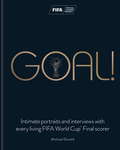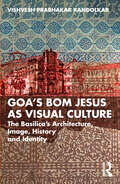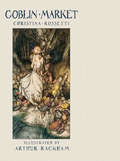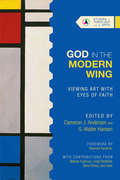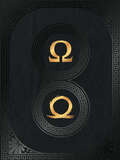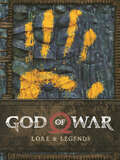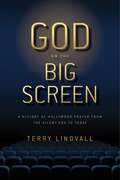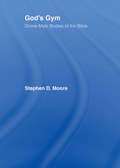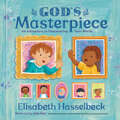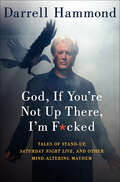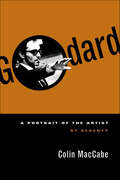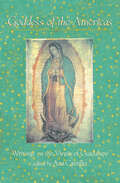- Table View
- List View
Go Crochet! Skill Builder: 30 Crochet-in-a-Day Projects to Take You from Beginner to Expert
by Ellen GormleyTake the Go Crochet! 30-day challenge! Go from crochet beginner to expert in only 30 days with 30 small projects tailored to expand your crochet repertoire. In addition to basic stitches for the crochet newbie, you'll also learn intermediate and advanced techniques, including Tunisian crochet, Bruges lace, broomstick lace, hairpin lace, tapestry crochet and beaded crochet. Work your way up, starting with the easiest projects and progressing to those with special stitches and techniques, or try literally going from the ground up, starting with boot cuffs and ending with hats! Pick any of a dozen approaches to this challenge and become a crochet master in no time. You can take the Go Crochet! Skill Builder challenge on your own, but it's also the perfect idea for a crochet-along with friends or at your local yarn shop. Get together to share techniques and tips while showing off your gorgeous yarns and finished projects.
Go Fish: How To Win Contempt And Influence People
by Mr Fish"Mr. Fish dissects the journalistic responsibility he faces as a cartoonist to make it make sense. It being his raw emotional output in response to a given stimuli (government, society, et al) manifesting itself via pen on paper without regard to the cleverly pointed punchline that will accompany and ultimately define it. . . The drawings are a celebration of the technical mastery and unbridled emotional truth of Dwayne Booth -- the Clark Kent to Superman's Mr. Fish."--Huffington Post"Fish's work makes you want to do something--even if you're not entirely sure what that something is--to change things for the better, and the feeling stays with you long after the book is closed."--Verbicide Magazine"Few individuals are as clued in to the volatility of the current political climate as iconic cartoonist Dwayne Booth (aka Mr. Fish). . . known for pointed and piquant single-panel cartoons that fearlessly and relentlessly take on the most sacred of cows in public life."--LA Weekly"A vibrant example of political cartooning as it is practiced at its heights... Anyone who thinks political cartooning is stale need only take a closer look at this body of work... Certifiably brilliant... The photographic elegance and immediacy with which this drawing is executed is typical of the most refined Mr. Fish style."--Los Angeles Review of BookThis debut volume of political cartoons from the revered Mr. Fish spans politics, popular culture, the economic crisis, the Obama presidency, and much more, where nobody--right, left, or middle--is safe from his razor-edged satire. The volume also includes original essays by Mr. Fish.Mr. Fish has been a freelance writer and cartoonist for eighteen years, publishing under both his real name (Dwayne Booth) and the penname of Mr. Fish with many of the nation's most reputable and prestigious magazines, journals, and newspapers. In addition to his weekly cartoon for Harper's and daily contributions to Truthdig.com, he has also contributed to the Los Angeles Times, the Village Voice, the LA Weekly, the Atlantic, the Huffington Post, Vanity Fair, Mother Jones, the Advocate, Z Magazine, the Utne Reader, Slate.com, MSNBC.com, and others.
Go Forth!
by Chronicle BooksGo Forth! is the perfect dose of positivity and kick-in-the-pants motivation to get out and get living, making, and doing. Chock-full of uplifting text-based art with an emphasis on being brave, courageous, and authentic, it's the perfect gift for grads, travelers, or anyone else in need of inspiration as they embark on a new adventure. Think Everything Is Going to Be OK and You Are So Loved with an audacious new look—bold, rather than sweet—fit for the contemporary reader.
Go Forth!
by Chronicle BooksA great graduation present or a gift for anyone beginning a new endeavor, a collection of inspiring quotes in modern, artistic designs. Go Forth! is the perfect dose of positivity and kick-in-the-pants motivation to get out and get living, making, and doing. Chock-full of uplifting text-based art with an emphasis on being brave, courageous, and authentic, it&’s the perfect gift for grads, travelers, or anyone else in need of inspiration as they embark on a new adventure. Think Everything Is Going to Be OK and You Are So Loved with an audacious new look—bold, rather than sweet—fit for the contemporary reader.
Go Green, Spend Less, Live Better: The Ultimate Guide to Saving the Planet, Saving Money, and Protecting Your Health
by Crissy TraskGo Green, Spend Less, Live Better is an authoritative, practical guide that details the money-saving side of greener, healthier, and simpler living. Bestselling author of It’s Easy Being Green and sustainable-living expert Crissy Trask provides a prescriptive handbook for making better decisions about our homes, how we get around, what we eat, and how we behave as consumers, in order to simultaneously achieve two desirable and imperative goals—to be better off financially and to do what is good for the planet.Laying out steps that will yield immediate results, Trask also provides explanations of bigger commitments that take time to implement, but also produce much bigger savings. With her practical money-saving strategies and environmental know-how, Trask empowers readers to confidently pursue change, knowing their bank accounts will grow as a result. Go Green, Spend Less, Live Better shows how typical families can easily save at least $10,000—and even as much as $30,000—in the first year alone by greening up some key areas of their homes and lives.Other areas covered include:How green living is not exclusive, but highly accessible and affordableFive reasons you will live better and save money when going greenHow to start reaping economic rewards right awayTaking green to the next level and getting more for your moneyEarning rich returns on green investmentsThe link between better health and greater wealthAnd much more!
Go High: The Unstoppable Presence and Poise of Michelle Obama
by M. SweeneyA photographic celebration of the elegance and inspiring strength of former First Lady Michelle Obama.Featuring more than fifty full-color photographs illustrating her warmth, wisdom, and belief in a bright future, this one-of-a-kind collection highlights Michelle Obama’s compassion, verve, and dynamic approach to unifying people from all walks of life. Each picture is accompanied by some of her most compelling words—inspirational quotes sharing her earnest belief that the United States of America is a place of unity, fairness, vitality, and optimism.A perfect gift for mothers and graduates, Go High revisits the beloved first lady’s heartfelt embrace of the American people, and her persistent encouragement to always lift one another up, reach higher, and rise to the occasion.
Go Set a Watchman Teaching Guide: Teaching Guide and Sample Chapters
by Harper Lee Amy JurskisWritten in the 1950s but unpublished until recently, Go Set a Watchman is neither a prequel nor a sequel to To Kill a Mockingbird, and attempting to read it as a simple continuation of the story does not do the work justice. As the adult Jean Louise, "Scout," returns to Macomb to visit Atticus, Go Set a Watchman perfectly captures a young woman, and a world, in painful yet necessary transition out of the illusions of the past—a journey that can only be guided by one’s own conscience. While many characters appear in both novels, some significant characters, like Boo Radley and Hank Clinton, exist in only one of the texts. Go Set a Watchman is also strikingly different in style and tone. Thematically complex and highly allusive, it is a novel that demands active and close reading.This ebook contains sample chapters from Go Set a Watchman and a teaching guide to help educators lead their students through an exploration of the themes, structure, and allusive references in Go Set a Watchman. Questions in the Guided Reading and Discussion section will help highlight the development of plot, character, and theme. Because the text features allusions that students are likely to be unfamiliar with, the guide also includes an index of annotated allusions to help facilitate close reading. Prompts for Writing and Research provide topics for longer writing tasks or research projects. Finally, this guide features an additional section that explores the writer’s craft by looking at both To Kill a Mockingbird and Go Set a Watchman.
Go de Rass to Sleep (A Jamaican translation): (A Jamaican translation)
by Adam MansbachA Jamaican patois translation of the New York Times, Amazon.com, and Wall Street Journal number one best seller and worldwide phenomenon. “No matter what the country or the language, parents all over the world—loving, frustrated, exhausted parents—know what Adam Mansbach means. Since 2011, his comically obscene picture book has sold more than 1.5 million copies in dozens of languages from Afrikaans to Japanese to Nynorsk. And later this year, his little book will venture into new territory with a Jamaican patois translation: ‘Go de R–s to Sleep.'” —The Washington Post/Style Blog “This version of Adam Mansbach’s profane, affectionate, and radically honest book will remind whole new audiences about the absurdities of parenting. Just don’t read it to the kids.” —Advocate.com, The 20 Greatest New Father’s Day Gifts The best-selling Go the F*** to Sleep has been translated into over thirty languages worldwide. Now it is finally translated for Jamaican and other Caribbean parents of the world. Go de Rass to Sleep is a bedtime book for parents who live in the real world, where a few snoozing kitties and cutesy rhymes don’t always send a toddler sailing blissfully off to dreamland. Profane, affectionate, and radically honest, California Book Award–winning author Adam Mansbach’s verses perfectly capture the familiar—and unspoken—tribulations of putting your little angel down for the night. In the process, they open up a conversation about parenting, granting us permission to admit our frustrations, and laugh at their absurdity. With illustrations by Ricardo Cortés, Go de Rass to Sleep is beautiful, subversive, and pants-wettingly funny—a book for parents new, old, and expectant. You probably should not read it to your children.
GoPro Cameras (Idiot's Guides)
by Chad FahsPeople love to capture their lives in colorful shots and movies they can place on YouTube, Facebook, or their own websites. Rugged and lightweight, GoPro cameras empower their users by providing powerful technology to tell stories that strike the right balance of words and pictures. These high-tech cameras enable users to capture powerful images—whether it&’s the miraculous beauty of a shark swimming by a coral reef or a motocross biker flying. However, users can&’t just thrust this camera underwater or attach it to a bike and hope for the best. They need to understand the basics about how to correctly operate, mount, and care for this camera in all types of environments. It's crucial to learn the camera&’s capabilities before they start spending serious cash on accessories and actually using it. The full-color illustrated Idiot&’s Guides®: GoPro Cameras covers: - The fundamental basics of the GoPro and understanding your personal expertise. - Familiarizing yourself with your camera and understanding lighting in differing environments (land, air, sea). - The pros and cons of getting it wet. - Mounting the camera to an object or mounting it to your person for shoots. - Accessorizing with specialty mounts, differing housing, electronic additions, and additional items like fog filters. - Knowing how to frame and photograph great shots and capture action. - 40 step-by-step projects utilizing your GoPro camera to capture your favorite active sports (such as biking, basketball, archery, etc.), in addition to engaging home life events (such as pet antics, nature, childplay, etc.)
GoPro Cameras For Dummies
by John CarucciYou only get one chance to take the perfect action shot The GoPro camera has taken the market by storm. Durable andweatherproof, these cameras are tailor-made for athletes,filmmakers, journalists, and hobbyists who want a hands-freedevice. Whether you're BASE-jumping, mountain biking, surfing, orjust shooting the next big indie masterpiece, GoPro Cameras ForDummies has you covered with information on how to get the bestphotos and videos from your camera.Jumpstart your GoPro experience, with helpful advice on how tocreate and share action-packed photos and videos. Plus you'll getprofessional insight on how to mount, set, and control your camerafor best results no matter the shooting conditions, and how toedit, add music, and share your finished piece. Step-by-stepinstructions walk you through each process, helping you getacquainted with the GoPro's controls and settings until you'reconsistently getting great footage. This helpful guide is packedwith full-color, full-page examples of GoPro photos from top users,to inspire you to get the most from your new camera.Choose the right camera and add the right accessoriesMaster the settings for any environmentEstablish framing, work with lighting, and capture soundEdit your images, and put them together as a projectRather than risk bad results with the school of trial by error,master your camera with the help of a professional photographer andvideographer. The best action shots can't be re-created, so knowwhat you're doing going in so you can nail that shot the firsttime. If you're ready to get out there and start shooting, grabyour gear and grab GoPro Cameras For Dummies, your personalGoPro coach.
Goal!: Intimate portraits and interviews with every living FIFA World Cup Final scorer
by Michael DonaldBeautifully illustrated and officially licensed by FIFA, Goal! is a unique football book that captures the essence of the ultimate sporting achievement.This is a fascinating portrait of the men who have lived the dream of every football fan worldwide. Includes: Intimate portraits by award-winning photographer Michael DonaldInterviews with the players, giving fascinating insight into the occassion, from the music they played on the bus to the stadium, to the meal they ate afterwardsProfiles on Pelé, Ronaldo, Zidane, Götze annd many more of the greatsThe book includes the story of what happened in each FIFA World Cup?, what happened to the players afterwards and what they do today. There's also a comprehensive statistics section covering all the facts and figures for each World Cup tournament so readers can relive the matches they saw, and discover the details about the ones they didn't.
Goa’s Bom Jesus as Visual Culture: The Basilica’s Architecture, Image, History and Identity
by Vishvesh Prabhakar KandolkarThis book chronicles the visual history of the Basilica of Bom Jesus, one of the longest-surviving churches from Goa’s Portuguese colonial era. In the sixteenth century, this baroque church in Old Goa was constructed to house the sacred relics of St. Francis Xavier and is emblematic of Goa Dourada or Golden Goa.Despite their early modern origins, monuments like the Basilica continue to influence visual culture that pertains to Goa. Accordingly, this book uncovers the traces of architectural images of Goa’s sixteenth- and seventeenth-century monuments and conducts a genealogical study of how uses of religious architecture shift over time. Thus, even as the Basilica originally functioned to portray or recall a grand empire by evoking the notion of Goa Dourada, its iconicity has been employed in marking Goa’s difference from the rest of India thereafter. By employing an analysis of historical texts, illustrations, photography, film, and pageantry, this volume demonstrates how the image of the Basilica has been employed to create a discourse on Goan identity. In fact, right from the colonial period, when Goa was heralded as the Rome of the East, to the post-Portuguese period, when Goa became an idyllic destination for leisure tourism, architectural images of Bom Jesus have been central in shaping Goa’s identity.Goa’s Bom Jesus as Visual Culture will be useful to students and educators in the fields of architecture, history, anthropology, sociology, history of architecture, and colonial/postcolonial studies. Finally, the long history of a single monument that the book documents highlights how Goans have been shaping their unique culture. At the same time as Goans imbibed Portuguese and other European influences, they also domesticated and remade such colonial heritage in South Asian fashion and, in turn, contributed to global aesthetics.
Goblin Market: The Prince's Progress, And Other Poems (Dover Fine Art, History of Art #No. 53)
by Christina Rossetti Arthur RackhamThis lovely gift edition of Christina Rossetti's most famous poem will enchant readers of all ages. For children, the story offers a captivating adventure into a land of fantasy. For adults, it's a lyric and sensual allegory of temptation, sacrifice, and salvation. Arthur Rackham, a peerless illustrator of fairy tales and supernatural creatures, portrays the poem's otherworldly attractions in 4 color and 20 black-and-white images plus a reproduction of a rare watercolor.
God Is Not a Christian, Nor a Jew, Muslim, Hindu...
by Carlton PearsonThe author of The Gospel of Inclusion continues to rouse organized religion as he raises controversial issues and provides enlightening answers to the deepest questions about God and faith. What is God? Where is God? Who is the one true God? Questions such as these have driven a thousand human struggles, through war, terrorism, and oppression. Humanity has responded by branching off into multiple religions, including Christianity, Judaism, Islam--each one pitted against the other. But it doesn't have to be that way.In God Is Not a Christian, nor a Jew, Muslim, Hindu . . . , the provocative and acclaimed Bishop Carlton Pearson follows up on his celebrated first book, The Gospel of Inclusion, to tackle these questions and many more, exploring new ideas about God and faith and putting forth the stunning assertion that God belongs to no particular religion but is an ever-loving presence available to all. For these beliefs, Bishop Pearson lost his thriving Pentecostal ministry but was catapulted instead into a greater pulpit. His readership has grown through appearances on national television and an extensive speaking schedule. With the world in the midst of a holy war, there is no better time for the wisdom of Bishop Pearson to reach a global audience.Bishop Pearson's many loyal fans, along with new readers, will surely welcome this provocative and eye-opening exploration of a deeper faith, one that goes far beyond any fundamentalist way of thinking, be it Christian, Jewish, Muslim, Hindu, etc. Simply put, Bishop Pearson dares to tell the truth so many others are too afraid to face.
God Is Red: A Native View of Religion (updated edition)
by Vine Deloria Jr.Deloria, a Native American educator, lawyer, and philosopher, has updated his classic work on native religion. In God is Red Deloria argues that Christianity has failed today's society, and describes basic tenets that underlie Native religions.
God in the Modern Wing: Viewing Art with Eyes of Faith (Studies in Theology and the Arts Series)
by G. Walter Hansen Cameron J. Anderson Cameron J. Anderson, G. Walter HansenShould Christians even bother with the modern wing at the art museum? After all, modern art and artists are often caricatured as rabidly opposed to God, the church—indeed, to faith of any kind. But is that all there is to the story? In this Studies in Theology and the Arts volume, coeditors Cameron J. Anderson and G. Walter Hansen gather the reflections of artists, art historians, and theologians who collectively offer a more complicated narrative of the history of modern art and its place in the Christian life. Here, readers will find insights on the work and faith of artists including Marc Chagall, Jackson Pollock, Mark Rothko, Andy Warhol, and more. For those willing to look with eyes of faith, they may just find that God is present in the modern wing too.
God of War: 20th Anniversary Retrospective
by Rick BarbaA full-color hardcover two-book set collecting detailed commentary on the past twenty years of the hit God of War games!&“War does not measure the strength of a man!&”—Kratos, God of War RagnarökThe epic of Kratos was born in blood across the backdrops of Sparta, Olympus, and Hades. The myth grew, weaving between the nine realms of the Aesir, Vanir, and Jötun. Now, readers are invited to journey alongside Kratos&’ mortal creators with a two-volume retrospective chronicling the twenty-year development of the renowned God of War series.Kratos&’ saga spans eons and pantheons, and now the creation of those stories can be explored in fastidious detail—from inspired conception and dedicated development to masterful performances and trend-setting design, all through exclusive and intimate interviews with the creative teams that have lent their passion and talent to the award-winning franchise.The God of War: 20th Anniversary Retrospective is the perfect book set for fans of the iconic game series, and lovers of action-adventure games and mythology. The trials and triumphs of the immortal patron of bloodshed all begin here.
God of War: Lore and Legends
by Rick Barba Sony StudiosA digital tome that authentically recreates Atreus' journal as seen in God of War, with expanded lore written in collaboration with game director Cory Barlog!The hit game is brought to life in a tangible and exciting new way as readers are invited to plumb the lore of God of War through the eyes of Kratos' son, Atreus. This digital volume chronicles Atreus and Kratos' journey through the fabled Nine Realms, from the Wildwoods of Midgard to the mountains of Jötunheim and beyond. In addition to the record of their mythic journey, this wonderous collection also includes a bestiary that was assembled during those travels, intimate dossiers of the characters that inhabit the masterfully crafted universe, and much more!Dark Horse Books and Santa Monica Studios present God of War: Lore and Legends. This lovingly produced edition is a must own item for any fan of God of War.
God on the Big Screen: A History of Hollywood Prayer from the Silent Era to Today
by Terry LindvallLinks film history with church history over the past century, illuminating America’s broader relationship with religious currents over time Moments of prayer have been represented in Hollywood movies since the silent era, appearing unexpectedly in films as diverse as Rebecca of Sunnybrook Farm, Frankenstein, Amistad, Easy Rider, Talladega Nights, and Alien 3, as well as in religiously inspired classics such as Ben-Hur and The Ten Commandments. Here, Terry Lindvall examines how films have reflected, and sometimes sought to prescribe, ideas about how one ought to pray. He surveys the landscape of those films that employ prayer in their narratives, beginning with the silent era and moving through the uplifting and inspirational movies of the Great Depression and World War II, the cynical, anti-establishment films of the 60s and 70s, and the sci-fi and fantasy blockbusters of today. Lindvall considers how the presentation of cinematic prayer varies across race, age, and gender, and places the use of prayer in film in historical context, shedding light on the religious currents at play during those time periods.God on the Big Screen demonstrates that the way prayer is presented in film during each historical period tells us a great deal about America’s broader relationship with religion.
God's Gold: A Quest for the Lost Temple Treasures of Jerusalem
by Sean KingsleyIn 70 AD, the Roman emperor Vespasian and his son Titus plundered the great Temple of Jerusalem, claiming for themselves a priceless hoard. The golden candelabrum, silver trumpets, the bejeweled Table of the Divine Presence—the central icons of the Jewish faith—were cast adrift in Mediterranean lands and exposed to centuries of turbulent history and the rule of four different civilizations. Only an intriguing trail of clues remains to betray the treasure's ever-changing destiny—a trail eminent archaeologist Dr. Sean Kingsley has followed on one of the most remarkable quests of this or any other age: the search for the final resting place of God's gold.
God's Gym: Divine Male Bodies of the Bible
by Stephen MooreIn this strikingly original work, Stephen Moore considers God's male bodies--the body of Yahweh in the Hebrew Bible, and the Father of Jesus Christ, and Jesus himself in the New Testament--and our obsessive earthly quest for a perfect human form. God's Gym is about divinity, physical pain, and the visions of male perfectability. Weaving together his obsession with human anatomy and dissection, an interest in the technologies of torture, the cult of physical culture, and an expert knowledge of biblical criticism, Moore explains the male narcissism at the heart of the biblical God. God's Gym is an intensely personal book, brimming with our culture's phobias and fascinations about male perfectability.
God's Masterpiece: An Adventure in Discovering Your Worth
by Elisabeth HasselbeckJoin the New York Times bestselling author of Flashlight Night in this fun picture book tour of an art museum! As kids marvel at the vibrant colors and incredible designs, they learn that God has crafted them as His very own works of art.Join two curious children on an adventure through an art museum in this charming celebration of how God made us. From Claude Monet&’s peaceful water lilies to Georgia O&’Keeffe&’s stunning flowers, every piece the children see reflects the artist&’s God-given creativity. Elisabeth Hasselbeck&’s rhyming text connects the dots (or dot-dot-dots, in the case of master of pointillism Georges Seurat) to how God himself lovingly creates each of his children. Our God makes us one of a kind!You&’re priceless, don&’t you seeBecause there is no other youand there is no other me!
God, If You're Not Up There, I'm F*cked: Tales of Stand-Up, Saturday Night Live, and Other Mind-Altering Mayhem
by Darrell HammondA raw yet humorous memoir detailing the troubled life and mind of an American comic icon, as seen in Netflix’s Cracked Up: The Darrell Hammond Story.From his harrowing childhood filled with physical and emotional abuse, to a lifetime of alcoholism and self-mutilation, psychiatric hospitalizations and misdiagnoses, to the peak of fame and success as the longest-tenured cast member of Saturday Night Live (where his hilarious dead-on impressions of Bill Clinton, Dick Cheney, Chris Matthews, and a hundred other prominent figures ushered him to the peak of stardom), Darrell Hammond delves into the darkest corners of his life, both in front of and behind the camera, with brutal honesty and fierce comic wit.
Godard: A Portrait of the Artist at Seventy
by Colin MacCabeAn intimate portrait of the turmoil that spawned the New Wave in French Cinema, and the story of its greatest director, Jean-Luc Godard. Godard's early films revolutionized the language of cinema. Hugely prolific in his first decade--Breathless, Contempt, Pierrot le Fou, Alphaville, and Made in USA are just a handful of the seminal works he directed--Godard introduced filmgoers to the generation of stars associated with the trumpeted sexuality of postwar movies and culture: Brigitte Bardot, Jean Seberg, Jean-Paul Belmondo, and Anna Karina. As the sixties wore on, however, Godard's life was transformed. The Hollywood he had idolized began to disgust him, and in the midst of the socialist ferment in France his second wife introduced him to the activist student left. From 1968 to 1972, Europe's greatest director worked in the service of Maoist politics, and continued thereafter to experiment on the far peripheries of the medium he had transformed. His extraordinary later works are little seen or appreciated, yet he remains one of Europe's most influential artists.Drawing on his own working experience with Godard and his coterie, Colin MacCabe, in this first biography of the director, has written a thrilling account of the French cinema's transformation in the hands of Truffaut, Rohmer, Rivette, and Chabrol--critics who toppled the old aesthetics by becoming, legendarily, directors themselves--and Godard's determination to make cinema the greatest of the arts.
Goddess of the Americas: Writings on the Virgin of Guadalupe
by Ana CastilloGoddess of the Americas is a brilliant essay collection and an impassioned, unorthodox celebration of the Virgin of Guadalupe: mother goddess, patron saint of Mexico, protector of the downtrodden, who made her first appearance on American soil in 1531. Through a variety of forms -- original essays, historical writings, short fiction, drama, and poetry -- the illustrious contributors to this literary anthology examine the impact this potent deity, the Lady of Guadalupe, has had on the people and culture of Mexico, and her influence beyond that country, in Latin America, North America, and Europe.An unprecedented contribution to the literature of the Americas, Goddess of the Americas is an invigorating investigation, an idiosyncratic adoration, and a profound recognition of our need for the sacred, unwavering love of the mother goddess.Francisco Alarcon * Luis Alfaro * Gloria Anzaldua * Ronnie Burk * Rosario Castellanos * Ana Castillo * Denise Chavez * Sandra Cisneros * Felipe Ehrenberg * Clarissa Pinkola Estes * Rosario Ferre * Francisco Goldman * Guillermo Gomez-Pena * F. Gonzalez-Crussi * Nancy Mairs * Ruben Martinez * Pat Mora * Cherrie Moraga * Octavio Paz * Elena Poniatowska * Margaret Randall * Jeanette Rodriguez * Luis Rodriguez * Richard Rodriguez * Miriam Sagan * Luisah Teish * Liliana Valenzuela

